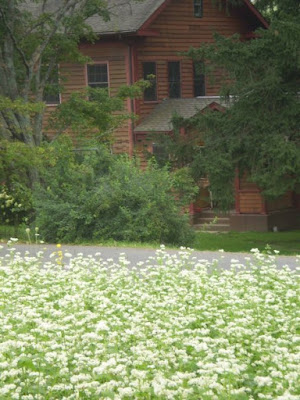With maple syrup season in full swing and pancake breakfasts offering buckwheat pancakes, it seems appropriate to share this lyrical description of a common farm cover crop from early fall in 1926.
The fields are white now with what J.C. Galloway writes about in The Port Allegany Argus and Reporter: "A tiny triangular box of black or gray, filled with a cake of white powder; What a wonder box of magic it is!
 |
| from our buckwheat seed stash |
"A bare plowed field in early summer; a few bushels of the wonder boxes scattered over it, a rain, and in a few weeks the fields are covered with white snow. Go closer, and one sees shining glassy stems standing thickly, dressed with leaves, and at the top, rows and rows of little waxen palaces filled with honey, fragrant and sweet and heavy; honey for the bees and honey for the farmer who plowed the ground and gave them their chance to grow.A little later, and the shining stems and the tops are heavy with the wonder boxes again, twenty or fifty, or a hundred to one; enough to work the same magic another year, and a great deal over which to bless the world. Well done, little buckwheat.”
 |
| Buckwheat growing as Metzger Heritage Farm Summer of 2009 |
3 comments:
Sweet writing. I seem to recall that Grandaddy Bill Fish had cronies named Dilloway and Galloway. I was also wondering if buckwheat is a legume that gets nitrogen into the soil.
Not a legume but a member of Polygonaceae, the same family as rhubarb. This is from Wikipedia:
"Buckwheat is a short-season crop that grows well in low-fertility or acidic soils; too much fertilizer – especially nitrogen – reduces yields, and the soil must be well drained. In hot climates buckwheat can be grown only by sowing late in the season, so that it blooms in cooler weather. The presence of pollinators greatly increases yield and nectar from flowering buckwheat produces a dark-colored honey."
"The buckwheat plant has a branching root system with a primary taproot that reaches deeply into moist soil. It grows 75 to 125 centimetres (30 to 50 inches) tall. Buckwheat has triangular seeds and produces a flower that is usually white, although can also be pink or yellow. Buckwheat branches freely, as opposed to tillering or producing suckers, enabling more complete adaption to its environment than other cereal crops. The seed hull is less dense than water, making the hull easy to remove by floating it away."
"Buckwheat is raised for grain where only a brief time is available for growth, either because the buckwheat is an early or a second crop in the season, or because the total growing season is limited. It establishes quickly, which suppresses summer weeds, and can be a reliable cover crop in summer to fit a small slot of warm season. Buckwheat has a growing period of only 10–12 weeks and it can be grown in high latitude or northern areas. Buckwheat is sometimes used as a "green manure", as a plant for erosion control, or as wildlife cover and feed."
Buckwheat! I love buckwheat pancakes. If my memory serves: My mother used to make batter for them the day before and let it wait upon the counter till the next da to make the "cakes" They were so good. The brief fermentation time gave them a slight tang and also formed the leavening to make them incredibly light snd fluffy. So darned good. I occasionally buy buckwheat pancake mix--NO comparison.
Post a Comment